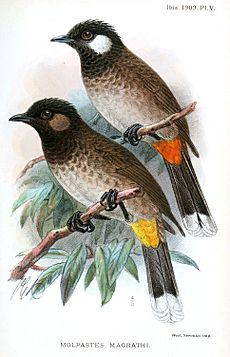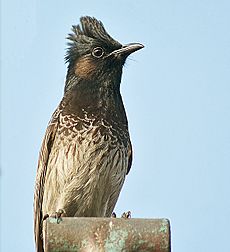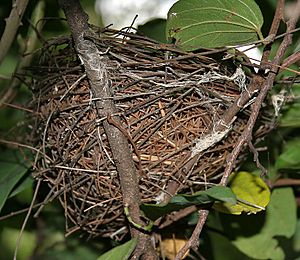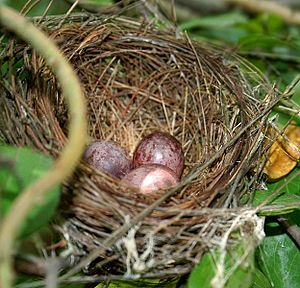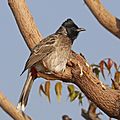Red-vented bulbul facts for kids
Quick facts for kids Red-vented bulbul |
|
|---|---|
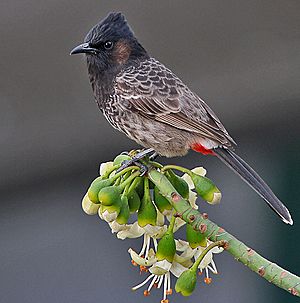 |
|
| P. c. bengalensis (Kolkata, India) | |
| Conservation status | |
| Scientific classification | |
| Kingdom: | |
| Phylum: | |
| Class: | |
| Order: | |
| Family: | |
| Genus: |
Pycnonotus
|
| Binomial name | |
| Pycnonotus cafer (Linnaeus, 1766)
|
|
The red-vented bulbul (Pycnonotus cafer) is a type of bird. It belongs to the bulbul family, called Pycnonotidae.
These birds live in warm, tropical parts of southern Asia. You can find them from India and Sri Lanka all the way east to Myanmar and southwestern China. They have also been taken to many Pacific islands, like Fiji, Samoa, Tonga, and Hawaii. You can also find them in parts of Dubai, the United Arab Emirates, and New Zealand. Sadly, they are known as one of the world's worst introduced species because they can cause problems in new places.
Contents
What Does the Red-vented Bulbul Look Like?
The red-vented bulbul is easy to spot! It has a short crest on its head, which makes its head look a bit square. Its body is dark brown with a pattern that looks like scales. The head is even darker, sometimes black.
A special feature is its white rump (the lower back) and a bright red area under its tail, called the vent. Its black tail has a white tip. Bulbuls living in the Himalayas have a bigger crest and more streaks on their belly.
Both male and female birds look very similar. Young birds are usually a bit duller in color than adult birds. Their typical call sounds like "ginger beer," but they also make sharp, single notes that sound like "pick." Other birds often listen to and understand their alarm calls.
Sometimes, you might see a bulbul with unusual colors, like very dark (melanistic) or very light (leucistic) feathers.
Where Do Red-vented Bulbuls Live?
These birds like dry areas with bushes, open forests, flat lands, and farms. In their home countries, they usually don't live in very thick, old forests. Studies in India show that the type of plants in an area is the most important thing for where these birds live.
Red-vented bulbuls have been brought to places like Hawaii and Fiji. They arrived in Samoa in 1943 and became common by 1957. In Fiji, they were brought around 1903. They also settled on the Tongan islands of Tongatapu and Niuafo'ou.
They were introduced to Melbourne, Australia, around 1917 but disappeared by 1942. In Auckland, New Zealand, they appeared in the 1950s but were removed. Another group was found and removed in 2006. In 2013, more were found, and people offered a reward for catching them.
In these new places, they prefer dry, low-lying areas. They are sometimes seen as pests because they can damage fruit crops. They can also help spread the seeds of invasive species like Lantana camara and Miconia calvescens, which can harm local plants.
Daily Life and Habits
Red-vented bulbuls eat many different things. They enjoy fruits, flower petals, and nectar. They also eat insects and sometimes even small lizards called geckos. They have even been seen eating the leaves of alfalfa plants.
Nests and Reproduction
Red-vented bulbuls build their nests in bushes, usually about 2 to 3 meters (6 to 10 feet) off the ground. A normal nest has two or three eggs. Sometimes, they even build nests inside houses or in a hole in a mud bank! One time, a nest was found floating on water hyacinth leaves. Another time, a pair nested inside a bus that was used regularly. They have also been seen nesting in holes in trees.
They usually breed from June to September. Their eggs are light pink with darker red spots, especially at the wider end. They can have several groups of babies in one year. Their nests are small, flat cups made of tiny twigs, but sometimes they use metal wires.
The eggs hatch after about 14 days. Both parents feed the baby birds. When they feed the chicks, they wait for the young to poop and then swallow the waste sacs to keep the nest clean. The pied crested cuckoo is a brood parasite of this species. This means the cuckoo lays its eggs in the bulbul's nest, and the bulbul raises the cuckoo chicks. Fires, heavy rains, and predators are the main reasons why young bulbuls don't survive in southern India.
Calls and Impact on Nature
Their calls are usually the same and they call all year round. However, scientists have found different types of calls, such as calls for roosting (sleeping), begging, greeting, flying, and two kinds of alarm calls.
These birds are important for spreading the seeds of plants like Carissa spinarum. This helps new plants grow in different areas.
Red-vented bulbuls, like many other birds, cannot make their own vitamin C. They need to get it from the food they eat.
These bulbuls can also affect other animals. For example, on the island of Oahu in Hawaii, red-vented bulbuls have caused changes in the population of Monarch butterflies. Over 20 years, the number of white Monarch butterflies has increased because the bulbuls prefer to eat the orange ones.
Images for kids
-
P. c. humayuni in Rajasthan, India
See also
 In Spanish: Bulbul cafre para niños
In Spanish: Bulbul cafre para niños



